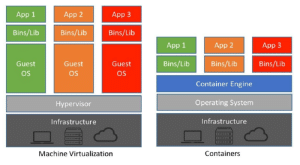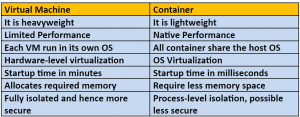Containerization is the process of containing applications with required libraries, configuration files, frameworks and all necessary dependent files that can be useful for running that particular application. It is simple all in one package environment to run applications efficiently on all hardware infrastructure. In short we can say that a container is an encapsulation of an application and its required environment to run. Containerization is OS level virtualization methodology to run any application with required library, configuration file, and frameworks integrated in container and it runs on OS level resources.
For Free, Demo classes Call: 8087886210
Registration Link: Click Here!
Now let’s discuss about container and its related important terms:
What is Docker –
- Docker is an open-source Centralized Platform tool designed to create, deploy and run applications on containers.
- Docker uses container on the host OS to run application. It allows applications to use the same Linux kernel OS a system on the host computer, rather than creating a whole virtual OS.
- We can install docker on any Operating System but Docker engine basically design for runs natively on Linux distribution.
- Docker code basically written in ‘go’ language, which generally develop for the write programs for the network infrastructure.
- Docker is a tool that performs OS level virtualization, also known OS Containerization.
- Before Docker, many users face the problem that a particular code is running in the developer’s system but not in the users system.
- Docker was developed by Solomon Hykes and Sebastien Pahl, it was release in March 2013.
- Docker is a set of Platform as a Service that achieve OS level resources (virtualization) whereas VMware tools uses Hardware level resources (Virtualization)
Docker Container –
- Container holds the entire package that is needed to run the any application on required system.
- In other words, we can say that, the image is a template and the container is a copy of that template.
- Container is like a Virtual Machine.
- Image becomes container when they run on docker engine
Advantages of Docker –
- Docker does not pre-allocate of RAM for run application.
- CI efficiency. Docker allows us to build a container image one time and use that the same image across every step of the deployment process.
- Less Cost
- It is light in weight
- It can run on physical hardware, virtual hardware (Virtual System) or on cloud base system
- You can re-use the image
- Docker take very less time to create container
For Free, Demo classes Call: 8087886210
Registration Link: Click Here!
Why Container –
- One of the challenges developers faced in the past is getting applications to run reliably across multiple computing environment. So many time it can’t run on customer system, developer test and run properly send to client side but when they try to run software it can’t run. And that’s where the concept of containers was born, it solve the old obstacle or drawbacks.
Introduction of Container –
- Linux containers can be thought of as a lightweight alternative to virtualization. In virtual machine configuration operating system create all OS setup, store all files, and run entire OS environment on guest operating system, it use all required system resources form the physical hardware, hypervisor manage all access of physical resources for the virtual system from physical hardware of host system.
- Whereas when Containers work by using a concept referred to as kernel sharing, then kernel share all resources with container on the basis of Operating system which takes advantage of the architectural design of Linux and UNIX-based OS.
- It creates Operating system level virtualization.
Introduction of Container –
- The main advantage of containers is that they require considerably less resource overhead than virtualization allowing many container instances to be run simultaneously on a single server, and can be started and stopped rapidly and efficiently with fast response. Containers run natively on the host system it use OS level virtualization that’s reason it providing a high performance that cannot be matched by a virtual machine.
Containers are work extremely portable and very easy to migrated one system to another system. When combined with a container management system such as Docker, OpenShift and Kubernetes, it is possible to deploy and manage containers on a vast scale spanning multiple servers and cloud platforms, potentially running thousands of container.
What are Container Images?
- Container images are static files images that ship with executable code that runs in an isolated environment. A container image are encapsulated all required environment such as system libraries, dependencies & other platform settings needed by the application to run in diverse environment on various host Operating Sys .
- Red Hat Linux provides a set of useful container tools that can manage container flexibly or you can leverage to work directly with Linux containers using requiring docker command line interface.
Virtualization Vs Container –

Virtualization Vs Container difference –

What is podman
Podman –
- Podman – for directly managing pods and container images (run, stop, start, ps, attach, exec, and so on)
- A Pod (as in a pod of whales or pea pod) is a group of one or more containers, with shared storage and network resources, and a specification
- Podman is similar to Docker and has the same command options like a docker which is use to manage containers.
- We can pull, run, and manage container image using podman tool in much the same way as you would with Docker. Podman available with lots of advanced integrated features as compaire with docker, fully integrates with systems, and offers user.
For Free, Demo classes Call: 8087886210
Registration Link: Click Here!
What is podman, Skopeo or buildah
Podman, Buildah, and Skopeo are a set of tools that is very useful and advance as compare with other competitive tools available in market to create, run, and manage software’s or applications across compatible Oracle Linux systems by using Open Container Initiative (OCI) compatible containers
Skopeo is a tool for moving container images between different types of container storages
Install podman Packages
#yum install podman
Install container Packages
#yum module install container-tools
For show podman help
#podman help
For check podman available images
#podman images
For search ubuntu image
#podman search ubuntu
For pull ubuntu
#podman pull docker.io/library/ubuntu
For check available images
#podman images
For search httpd
# podman search httpd
Pull from docker library
# podman pull docker.io/library/httpd
For show
#podman images
For run ubuntu in container
#podman run -dt docker.io/library/ubuntu /bin/bash
For display process
# podman ps
To execute
#podman exec -t c122a6k4actek /bin/bash
#whoami
#cat /etc/passwd
#uname
#uname -a
For Exit
#exit
#podman ps -a
Show image and run
#podman images
#podman run -dt -t -p 8080:80 docker.io/library/httpd
#podman ps -a
To verify
Open web browser and type following ip address
http:127.0.0.1:8080
Default page show “it works”
To stop podman
#podman ps -a
#podman stop <name>
#podman start <name>
#podman rm <name>
Abhijeet Dahatonde
Call the Trainer and Book your free demo Class Call now!!!
| SevenMentor Pvt Ltd.
© Copyright 2021 | Sevenmentor Pvt Ltd.

